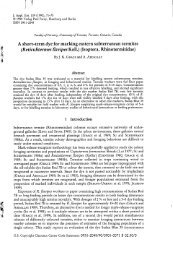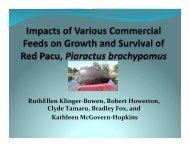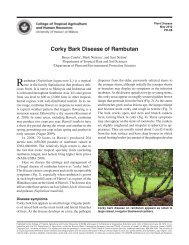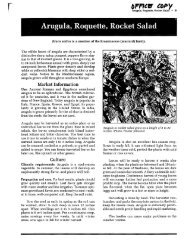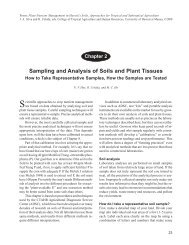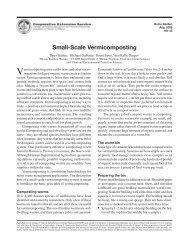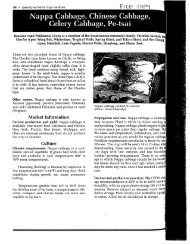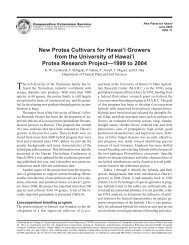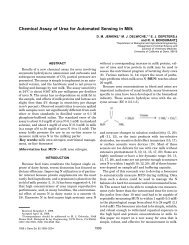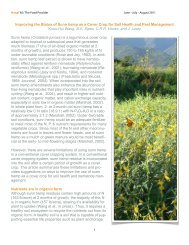Macadamia Nuts in Hawaii: History and Production - ctahr ...
Macadamia Nuts in Hawaii: History and Production - ctahr ...
Macadamia Nuts in Hawaii: History and Production - ctahr ...
Create successful ePaper yourself
Turn your PDF publications into a flip-book with our unique Google optimized e-Paper software.
Figure 45. W<strong>in</strong>dbreaks <strong>in</strong> macadamia nut fields: Syncarpia laurifolia on the left <strong>and</strong> A raucaria excelsa on the right.<br />
Naqu<strong>in</strong> planted predom<strong>in</strong>antly the <strong>in</strong>tegrifolia<br />
at Honokaa, presumably because the Purvis <strong>in</strong>tegrifolia<br />
trees planted nearby were the major seed<br />
source. Van Tassel did the same for his orchard at<br />
Nutridge. Unfortunately, some of the trees planted<br />
<strong>in</strong> Keauhou, Kona, before Moltzau's time <strong>and</strong> used<br />
as <strong>in</strong>tercrop <strong>and</strong> shade sources <strong>in</strong> the coffee fields<br />
were tetraphyllas. Moltzau remembers demonstrat<strong>in</strong>g<br />
the tree topwork<strong>in</strong>g technique to Kona<br />
farmers by actually topwork<strong>in</strong>g hundreds of trees<br />
beg<strong>in</strong>n<strong>in</strong>g <strong>in</strong> 1928. Fortunately, he also persuaded<br />
the Kona farmers to plant <strong>in</strong>tegrifolias.<br />
All five cultivars named by Storey by that time<br />
were extensively planted at Keaau Orchard,<br />
beg<strong>in</strong>n<strong>in</strong>g <strong>in</strong> 1949. Only two of these, 'Keauhou'<br />
<strong>and</strong> 'Kakea', however, showed good commercial<br />
possibilities by 1953. The other cultivars were<br />
topworked with 'Keauhou', 'Kakea', <strong>and</strong>a recently<br />
named cultivar, 'Ikaika'.<br />
In 1952 Hamilton <strong>and</strong> Fukunaga named 'Ikaika'<br />
(HAES 333) <strong>and</strong> 'Wailua' (HAES 475), of which<br />
only 'Ikaika' is now cultivated commercially. In<br />
1966 Hamilton <strong>and</strong> Ooka (17), <strong>in</strong>troduced 'Keaau'<br />
(HAES 660), <strong>and</strong> <strong>in</strong> 1971 Hamilton <strong>and</strong> Nakamura<br />
(18) <strong>in</strong>troduced 'Ka'u' (HAES 344). Hamilton <strong>and</strong><br />
Ito (19) named 'Mauka' (HAES 741) <strong>and</strong> 'Makai'<br />
(HAES 800) <strong>in</strong> 1977, imply<strong>in</strong>g that cultivar<br />
'Mauka' is for the higher elevations above 1800<br />
feet <strong>and</strong> cultivar 'Makai' is suited to elevations<br />
below 1600 feet. In a paper presented at the 1981<br />
36<br />
annual meet<strong>in</strong>g of the <strong>Macadamia</strong> Producers<br />
Association, Hamilton (20) named two new cultivars,<br />
'Purvis' (HAES 294) <strong>and</strong> 'Pahala' (HAES<br />
788).<br />
As of this date, 13 M. <strong>in</strong>tegrifolia cultivars <strong>in</strong><br />
<strong>Hawaii</strong> have been assigned names. The older<br />
orchards are predom<strong>in</strong>antly planted to 'Keauhou',<br />
'Kakea', <strong>and</strong> 'Ikaika', the cultivars then available.<br />
The more consistent cultivar recommendation<br />
currently given by most farmers is to plant 'Kakea',<br />
'Ka'u', <strong>and</strong> 'Keaau'. The nut size of 'Keaau' is<br />
somewhat small, but it is a good yielder of both <strong>in</strong>shell<br />
nuts <strong>and</strong> quality kernels. It is also a th<strong>in</strong>nershelled<br />
nut <strong>and</strong> possibly can be recommended as a<br />
seed source. It is also a more conf<strong>in</strong>ed tree <strong>and</strong> is,<br />
therefore, more economical <strong>in</strong> terms of space.<br />
'Ka'u', a relatively new variety, is also a conf<strong>in</strong>ed,<br />
upright tree that seems to be more w<strong>in</strong>d tolerant<br />
<strong>and</strong> yields heavily.<br />
Clonal Tree Propagation<br />
Rootstock. The structural formation of the<br />
roots on the rootstocks used <strong>in</strong> graft<strong>in</strong>g macadamia<br />
nut trees is one of the most important<br />
aspects <strong>in</strong> tree production. Root structural<br />
evidence collected <strong>in</strong> the last 20 years seems to<br />
<strong>in</strong>dicate that the method now employed could be<br />
modified to lessen the expensive <strong>and</strong> eventual loss<br />
of trees <strong>in</strong> a develop<strong>in</strong>g orchard.



